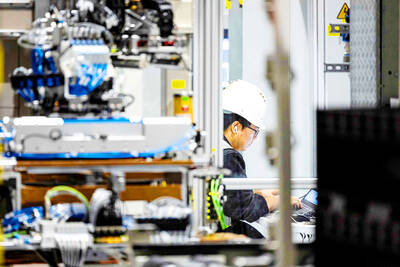Low interest rates and favorable tax environments are stoking the fires of takeovers, with about a quarter of big groups now on the lookout for targets in the next 12 months, a study found last week.
“Plans for transformational acquisitions are accelerating,” the survey by consultancy Ernst and Young (EY) concluded.
The pharmaceutical sector has led the way so far this year with deals worth US$150 billion, according to consultancy Dealogic, and that does not include a failed bid worth US$117 billion by US firm Pfizer for British-Swedish group AstraZeneca.
On Friday, a bid worth US$46 billion by US drugs laboratory AbbVie was rejected by Shire Pharmaceuticals, which is listed in London and New York, but based in Dublin.
On Wednesday, US group Valeant launched a hostile bid of US$53.5 billion for Allergan.
Much of this is driven by a need to grow and cut costs to counter the expiration of some patents on high-earning drugs, analysts say.
The survey assessment by EY backs up comments from analysts for some time that ultra-low interest rates by several leading central banks are one of the main factors reigniting interest in takeovers.
Other forces are at work as well: During the financial crisis that began in 2008 and the subsequent eurozone debt crisis, many big companies restructured their businesses and hoarded cash. They did not have sufficient confidence in the outlook to invest, even by borrowing cheap money being pushed at the banking system by some central banks.
However, now many businesses are gaining confidence in the recovery and are looking to expand by buying other businesses, which can offer a faster route to growth than setting up new operations, and may be less risky.
EY interviewed 1,600 executives in companies in 54 countries. It found that the number of big groups willing to launch takeovers of than US$500 million had doubled in 12 months to 27 percent of the total. Those willing to do deals of more than US$1 billion had doubled to 12 percent.
Their willingness to take on debt to finance deals was the highest for five years.
Many companies are under pressure from aggressive shareholders to cut costs, which could make company boards highly selective in looking at targets.
“After a prolonged financial crisis and merger-and-acquisition [M&A] market malaise, companies and boards are opting for quality rather than quantity,” said the head of M&A activity in France for EY, Rudy Cohen Scali.
Recently US and European companies have led M&A activity, but emerging companies could begin to play a significant role, led by China and India, the report said.
“The top five investment destinations balance emerging markets such as India and China with a continued focus on mature markets such as the US, UK and Germany,” it found.
The EY report said that “30 percent of executives perceive global political instability to be the greatest economic risk.”
Henderson Global Investors’ data last month showed that in the first quarter of the year, big companies had raised dividend payouts to shareholders by nearly a third.
With the crises fading, and despite sluggish growth “all over the markets there is liquidity waiting to be used,” Paris-based Barclays Bourse portfolio manager Renaud Murail said then.
“American companies have accumulated huge warchests,” he said.
At investment group Amundi, global head of equities Romain Boscher said at the time: “The wave of mergers and acquisitions is just beginning.”
Cohen Scali said in the EY report: “The fundamentals for high-value deal-making are very favorable... However, the complexity of the challenge facing executives today means M&A is more measured.”
Michael Hewson, chief market analyst at CMC Markets UK, contested suggestions that the upsurge of M&A activity reflects renewed confidence in some parts of the global economy, saying that one driving factor was a search by US companies to use their piles of cash abroad in a way which would not attract tax if the money were sent to headquarters in the US.
Pfizer’s failed attempt to acquire AstraZeneca “was the most high-profile attempt” to use cash, he said.
With many stock markets close to record highs, boardrooms were considering buying back shares, or returning reserves to shareholders — citing Rolls-Royce this week as the latest example of this.
Attempts by US group General Electric to buy a large part of French engineering group Alstom could also be motivated in part by the fact that it had US$57 billion outside the US at the end of last year, he said.
This raised questions about “the value and reasons behind these deals,” Hewson said.

CHIP RACE: Three years of overbroad export controls drove foreign competitors to pursue their own AI chips, and ‘cost US taxpayers billions of dollars,’ Nvidia said China has figured out the US strategy for allowing it to buy Nvidia Corp’s H200s and is rejecting the artificial intelligence (AI) chip in favor of domestically developed semiconductors, White House AI adviser David Sacks said, citing news reports. US President Donald Trump on Monday said that he would allow shipments of Nvidia’s H200 chips to China, part of an administration effort backed by Sacks to challenge Chinese tech champions such as Huawei Technologies Co (華為) by bringing US competition to their home market. On Friday, Sacks signaled that he was uncertain about whether that approach would work. “They’re rejecting our chips,” Sacks

NATIONAL SECURITY: Intel’s testing of ACM tools despite US government control ‘highlights egregious gaps in US technology protection policies,’ a former official said Chipmaker Intel Corp has tested chipmaking tools this year from a toolmaker with deep roots in China and two overseas units that were targeted by US sanctions, according to two sources with direct knowledge of the matter. Intel, which fended off calls for its CEO’s resignation from US President Donald Trump in August over his alleged ties to China, got the tools from ACM Research Inc, a Fremont, California-based producer of chipmaking equipment. Two of ACM’s units, based in Shanghai and South Korea, were among a number of firms barred last year from receiving US technology over claims they have

It is challenging to build infrastructure in much of Europe. Constrained budgets and polarized politics tend to undermine long-term projects, forcing officials to react to emergencies rather than plan for the future. Not in Austria. Today, the country is to officially open its Koralmbahn tunnel, the 5.9 billion euro (US$6.9 billion) centerpiece of a groundbreaking new railway that will eventually run from Poland’s Baltic coast to the Adriatic Sea, transforming travel within Austria and positioning the Alpine nation at the forefront of logistics in Europe. “It is Austria’s biggest socio-economic experiment in over a century,” said Eric Kirschner, an economist at Graz-based Joanneum

France is developing domestic production of electric vehicle (EV) batteries with an eye on industrial independence, but Asian experts are proving key in launching operations. In the Verkor factory outside the northern city of Dunkirk, which was inaugurated on Thursday, foreign specialists, notably from South Korea and Malaysia, are training the local staff. Verkor is the third battery gigafactory to open in northern France in a region that has become known as “Battery Valley.” At the Automotive Energy Supply Corp (AESC) factory near the city of Douai, where production has been under way for several months, Chinese engineers and technicians supervise French recruits. “They